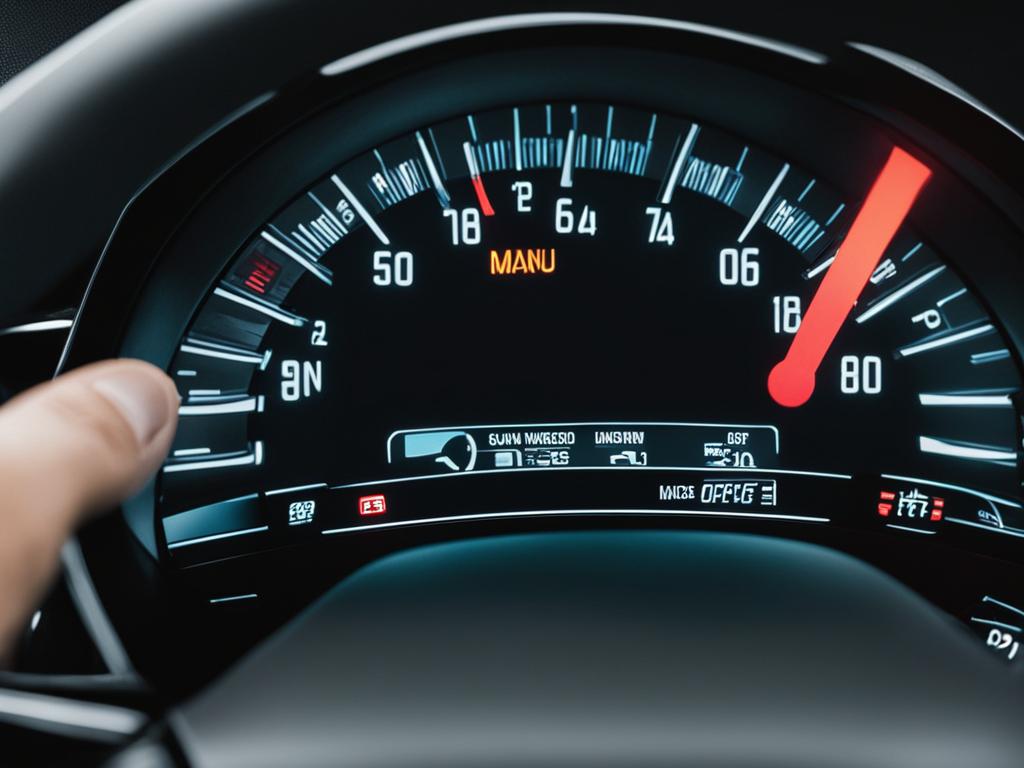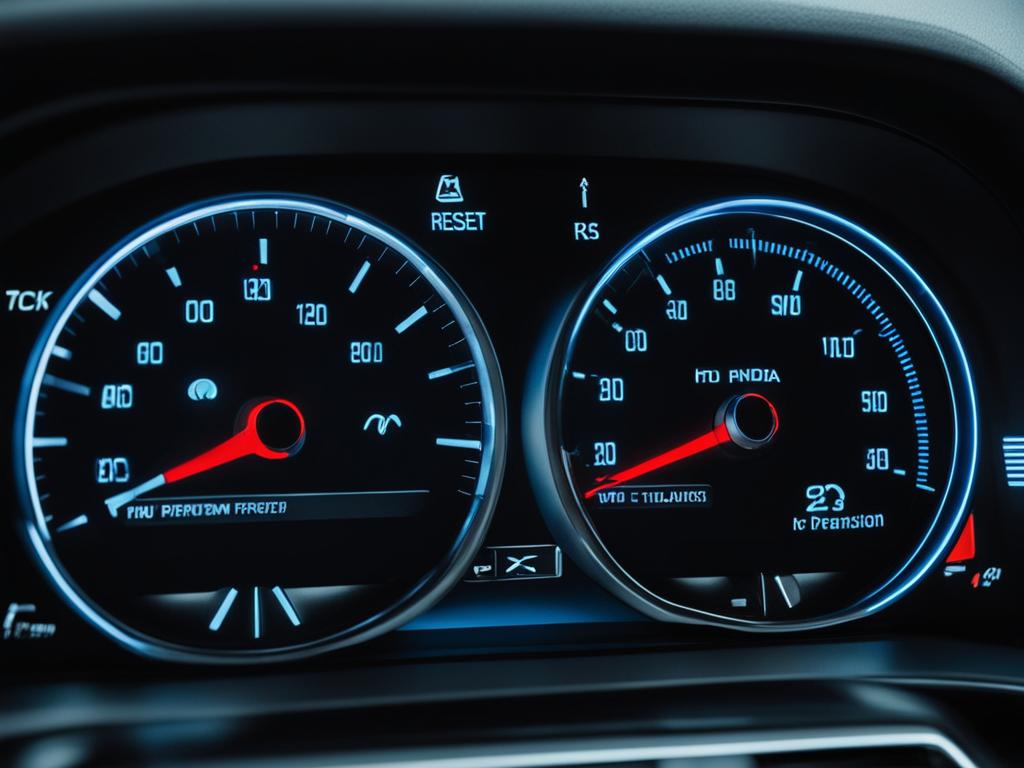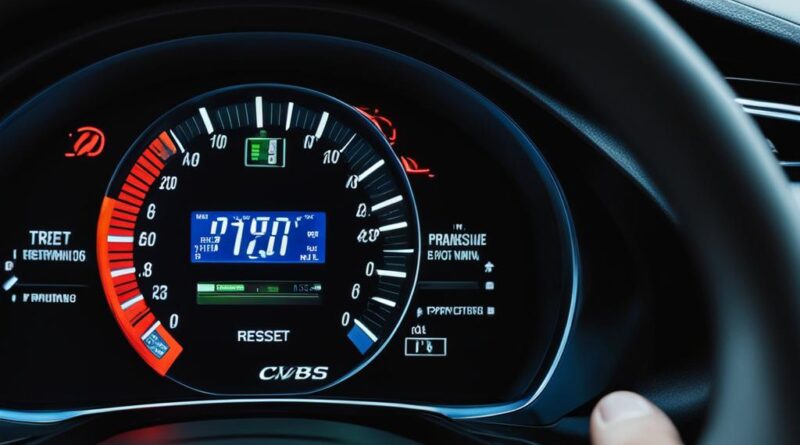Reset Tire Pressure Light on Honda Civic Easily
The tire pressure light in your Honda Civic can be reset easily with a few simple steps. By following these instructions, you can ensure that your tire pressure monitoring system (TPMS) is functioning properly. This guide will provide you with step-by-step instructions on resetting the tire pressure light in your Honda Civic.
Key Takeaways:
- Resetting the tire pressure light in your Honda Civic is a simple process that can be done with a few steps.
- Regularly checking and maintaining proper tire pressure is crucial for optimal vehicle performance and safety.
- If the tire pressure light won’t reset, it may indicate a more serious issue with the TPMS that requires professional attention.
- Newer Honda Civic models with a touchscreen display have a straightforward process for resetting the TPMS.
- Older Honda Civic models may require accessing the TPMS calibration option through steering wheel buttons.
Why Does the Tire Pressure Light Come On?
The tire pressure light in your Honda Civic may come on for various reasons. It could indicate low tire pressure, a TPMS malfunction, or other issues. It’s important to address the problem as soon as possible to ensure your safety on the road. In some cases, the tire pressure light may not reset even after inflating the tires, indicating a TPMS malfunction that may require professional assistance.
Low tire pressure is one of the most common reasons for the tire pressure light to come on. When the pressure in one or more of your tires drops below the recommended level, the TPMS sensor detects it and triggers the warning light. This could be due to a slow leak, changes in temperature, or natural air loss over time.
Another possible cause of the tire pressure light coming on is a malfunction in the TPMS system itself. This could be a result of a faulty sensor, a wiring issue, or a problem with the TPMS module. When the system fails to reset after inflating the tires to the correct pressure, it indicates a TPMS malfunction that needs to be diagnosed and repaired.
“Ignoring the tire pressure light can lead to unsafe driving conditions, decreased fuel efficiency, and uneven tire wear.”
It’s important not to ignore the tire pressure light when it comes on. Ignoring the warning light can lead to unsafe driving conditions, decreased fuel efficiency, and uneven tire wear. It’s crucial to address the issue promptly and take the necessary steps to reset the tire pressure light.
Common Causes of Tire Pressure Light Won’t Reset
If you’ve inflated your tires to the correct pressure but the tire pressure light won’t reset, there may be a few common causes:
- A TPMS sensor may be faulty or malfunctioning.
- There may be a problem with the TPMS module or wiring.
- The reset procedure may not have been followed correctly.
In these cases, it’s recommended to seek professional assistance from a qualified mechanic or visit a Honda service center to diagnose and fix the issue. They have the expertise and specialized tools to identify the exact cause of the problem and resolve it effectively.
Resetting TPMS in New Honda Vehicles
If you own a newer Honda Civic model with a touchscreen display, resetting the TPMS is a simple process. Just follow these steps:
- From the home screen, access the vehicle settings.
- Select TPMS calibration.
- Choose the option to calibrate the TPMS.
- Follow the on-screen instructions.
For Honda Civic models without a touchscreen display, the TPMS calibration can be accessed through the driver information screen. Here’s how:
- Use the steering wheel buttons to navigate to the vehicle settings.
- Select TPMS calibration.
- Choose the option to calibrate the TPMS.
- Follow the on-screen instructions.
By following these steps, you can easily reset the TPMS in your newer Honda Civic model and ensure that your tire pressure is accurately monitored.
Note: It’s important to consult your owner’s manual or contact your local Honda dealership for model-specific instructions and guidance.

Resetting the TPMS in newer Honda Civic models, whether equipped with a touchscreen display or a driver information screen, is a straightforward process. By accessing the vehicle settings and selecting the TPMS calibration, you can easily reset the TPMS and ensure that your tire pressure is accurately monitored.
Resetting TPMS in Older Honda Vehicles
Older Honda Civic models may have a different process for resetting the TPMS. These models typically have steering wheel buttons for accessing the vehicle settings. By pressing the menu button and navigating to the TPMS calibration option, you can select the option to initialize the TPMS. Some older models may also have a dedicated TPMS button located near the steering wheel that can be pressed and held to reset the tire pressure light.
| Steps to Reset TPMS in Older Honda Vehicles: |
|---|
|
What to Do If Tire Pressure Light Won’t Reset
If the tire pressure light in your Honda Civic won’t reset even after following the reset procedure, it could indicate a more serious issue with the TPMS. In this case, it is recommended to visit a service center or a professional mechanic to diagnose and fix the problem. They will have the necessary tools and expertise to identify the underlying issue and resolve it, ensuring that your TPMS is functioning properly.
It’s crucial not to ignore a persistent tire pressure light, as it could lead to potential safety hazards and affect your vehicle’s overall performance. By seeking professional assistance, you can address any underlying TPMS issues and reset the tire pressure light successfully.
| Steps to Follow if the Tire Pressure Light Won’t Reset: |
|---|
| Step 1: Take note of any additional symptoms or warnings displayed on your vehicle’s dashboard. |
| Step 2: Visit a service center or a qualified mechanic with experience in Honda vehicles. |
| Step 3: Communicate the issue to the technician and provide any relevant information regarding the TPMS malfunction. |
| Step 4: Allow the technician to perform a thorough inspection of your TPMS to identify the root cause of the problem. |
| Step 5: Based on their findings, follow the recommended course of action to repair or replace any faulty TPMS components. |
| Step 6: After the necessary repairs or replacements, the technician will reset the TPMS and ensure that the tire pressure light is no longer illuminated. |
Remember, the tire pressure light serves as an essential safety feature in your Honda Civic, so it’s crucial to address any issues promptly. By seeking professional help, you can ensure that your TPMS is functioning correctly and keep yourself and others safe on the road.

Importance of Maintaining Proper Tire Pressure
Ensuring that your Honda Civic maintains the proper tire pressure is crucial for several reasons. When your tires are underinflated or overinflated, it can have a significant impact on your vehicle’s performance, fuel efficiency, and overall safety. Regularly checking and maintaining your tire pressure is a simple task that can prevent various issues and optimize your driving experience. To achieve this, it’s essential to adhere to the recommended PSI (pounds per square inch) specified in your Honda Civic owner’s manual.
| Benefits of Maintaining Proper Tire Pressure |
|---|
| Enhanced Handling: Properly inflated tires promote better traction and responsiveness, improving your vehicle’s handling on the road. |
| Improved Fuel Efficiency: When your tires are at the correct pressure, your engine doesn’t have to work as hard, leading to better fuel efficiency and cost savings at the pump. |
| Optimal Safety: Inadequate tire pressure can compromise your vehicle’s stability, braking performance, and cornering ability, increasing the risk of accidents. Maintaining the correct tire pressure ensures maximum safety for you and your passengers. |
| Extended Tire Lifespan: Properly inflated tires wear evenly, reducing the chances of irregular wear patterns and extending the overall lifespan of your tires. |
By regularly monitoring and adjusting your Honda Civic’s tire pressure, you can prevent the low tire pressure light from illuminating and address potential issues before they escalate. It’s important to note that tire pressure can fluctuate with temperature changes, so it’s recommended to check your tire pressure at least once a month or before embarking on a long journey.
Proper Tire Pressure
The proper tire pressure for your Honda Civic can typically be found in your vehicle’s owner’s manual or on a sticker located on the driver’s side door jamb. It is crucial to follow these guidelines as different Honda Civic models and tire sizes might require different pressure specifications. Remember to check the pressure when the tires are cool, as driving can heat them up and lead to inaccurate readings.
If you’re uncertain about the correct tire pressure, consult a professional or visit a trusted tire shop for assistance. These experts can ensure that your tires are properly inflated and advise you on any specific considerations for your Honda Civic model.

“Maintaining the proper tire pressure in your Honda Civic is not only essential for your safety but also for the overall performance of your vehicle. By keeping a close eye on your tire pressure and adhering to the recommended guidelines, you can enjoy a smooth, fuel-efficient, and safe driving experience.”
Conclusion
Resetting the tire pressure light on your Honda Civic is a straightforward process that can be accomplished with just a few simple steps. By following the instructions provided in this guide, you can easily reset the TPMS and ensure that your tire pressure is accurately monitored.
Addressing any issues with the tire pressure light promptly is crucial in maintaining the safety and performance of your Honda Civic. Regularly checking your tire pressure and resetting the light as needed will help prevent the light from coming on and will ensure optimal driving conditions.
Remember, maintaining proper tire pressure is vital for various reasons, including handling, fuel efficiency, and overall safety. By resetting the tire pressure light and staying vigilant about tire pressure maintenance, you can enjoy a smooth and worry-free driving experience in your Honda Civic.
FAQ
How do I reset the tire pressure light on my Honda Civic?
To reset the tire pressure light on your Honda Civic, follow these steps:
Why is the tire pressure light coming on in my Honda Civic?
The tire pressure light in your Honda Civic may come on for various reasons, including low tire pressure or a TPMS malfunction.
How do I reset TPMS in newer Honda vehicles?
In newer Honda Civic models with a touchscreen display, access the vehicle settings, select TPMS calibration, and follow the on-screen instructions.
How do I reset TPMS in older Honda vehicles?
In older Honda Civic models without a touchscreen display, use the steering wheel buttons to access the vehicle settings, navigate to the TPMS calibration option, and select the option to initialize the TPMS.
What should I do if the tire pressure light won’t reset on my Honda Civic?
If the tire pressure light in your Honda Civic won’t reset even after following the reset procedure, it may indicate a more serious TPMS issue. Visit a service center or professional mechanic for diagnosis and repair.
Why is it important to maintain proper tire pressure in my Honda Civic?
Maintaining proper tire pressure in your Honda Civic is vital for vehicle handling, fuel efficiency, and overall safety. It is recommended to regularly check and maintain the recommended tire pressure specified in your owner’s manual.
How can I turn off the tire pressure light on my Honda Civic?
To turn off the tire pressure light on your Honda Civic, follow the steps for resetting the TPMS as mentioned earlier in this FAQ.




